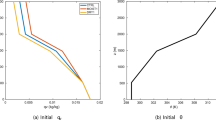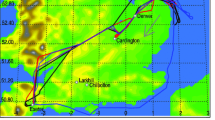Abstract
Results of a three-dimensional numerical model are analysed in a study of turbulence and entrainment within mixed layers containing stratocumulus with or without parameterized cloud-top radiative cooling. The model eliminates most of the assumptions invoked in theories of cloud-capped mixed layers, but suffers disadvantages which include poor resolution and large truncation errors in and above the capping inversion.
For relatively thick mixed layers with relatively thick capping inversions, the cloud-top radiative cooling is found to be lodged mostly within the capping inversion when the cooling is confined locally to the upper 50 m or less of the cloud. It does not then contribute substantially towards increased buoyancy flux and turbulence within the well mixed layer just below.
The optimal means of correlating the entrainment rate, or mixed-layer growth rate, for mixed layers of variable amounts of stratocumulus is found to be through functional dependence upon an overall jump Richardson number, utilizing as scaling velocity the standard deviation of vertical velocity existing at the top of the mixed layer (near the center of the capping inversion). This velocity is found to be a fraction of the generalized convective velocity for the mixed layer as a whole which is greater for cloud-capped mixed layers than for clear mixed layers.
Similar content being viewed by others
References
Albrecht, B. A., Betts, A. K., Schubert, W. H., and Cox, S. K.: 1979, ‘A Model of the Thermodynamic Structure of the Trade-Wind Boundary Layer: Part I. Theoretical Formulation and Sensitivity Tests’, J. Atmos. Sci. 36, 73–89.
André, J. C., De Moor, G., Lacarrère, P., and du Vachat, R.: 1976, ‘Turbulence Approximation for Inhomogeneous Flows: Part II. The Numerical Simulation of a Penetrative Convection Experiment’, J. Atmos. Sci. 33, 482–491.
Arakawa, A.: 1966, ‘Computational Design for Long-Term Numerical Integration of the Equations of Fluid Motion: Two-dimensional Incompressible Flow, Part I’, J. Comp. Phys. 1, 119–143.
Ball, F. K.: 1960, ‘Control of Inversion Height by Surface Heating’, Quart. J. Roy. Meteorol. Soc. 86, 483–494.
Betts, A. K.: 1973, ‘Non-precipitating Cumulus Convection and its Parameterization’, Quart. J. Roy. Meteorol. Soc. 99, 178–196.
Businger, J. A., Wyngaard, J. C., Izumi, Y., and Bradley, E. F.: 1971, ‘Flux-Profile Relationships in the Atmospheric Surface Layer’, J. Atmos. Sci. 28, 181–189.
Clarke, R. H., Dyer, A. J., Brook, R. R., Reid, D. G., and Troup, A. J.: 1971, ‘The Wangara Experiment: Boundary Layer Data’, CSIRO Div. of Meteorol. Phys. Tech. Paper No. 19, 340 pp.
Coulman, C. E.: 1978, ‘Convection in Stratiform Cloud’, J. Rech. Atmos. 12, 21–33.
Deardorff, J. W.: ‘Convective Velocity and Temperature Scales for the Unstable Planetary Boundary Layer’, J. Atmos. Sci. 27, 1211–1213.
Deardorff, J. W.: ‘Three-Dimensional Numerical Study of the Height and Mean Structure of a Heated Planetary Boundary Layer’, Boundary-Layer Meteorol. 7, 81–106.
Deardorff, J. W.: 1974b, ‘Three-Dimensional Numerical Study of Turbulence in an Entraining Mixed Layer’, Boundary-Layer Meteorol. 7, 199–226.
Deardorff, J. W.: 1976a, ‘On the Entrainment Rate of a Stratocumulus-Topped Mixed Layer’, Quart. J. Roy. Meteorol. Soc. 102, 563–582.
Deardorff, J. W.: 1976b, ‘Usefulness of Liquid-Water Potential Temperature in a Shallow-Cloud Model’, J. Appl. Meteorol. 15, 98–102.
Deardorff, J. W.: 1976c, ‘Clear and Cloud-Capped Mixed Layers: Their Numerical Simulation, Structure and Growth and Parameterization’, in Seminars on the Treatment of the Boundary Layer in Numerical Weather Prediction, European Centre for Medium Range Weather Forecasts, Reading, England, 6–10 Sept. 1976, 234–284.
Deafdorff, J. W.: 1980. ‘Cloudtop Entrainment Instability’, J. Atmos. Sci. 37, 131–147.
Findikakis, A. N. and Street, R. L.: 1979, ‘An Algebraic Model for Sub-grid-scale Turbulence in Stratified Flows’, J. Atmos. Sci. 36, 1934–1949.
Kahn, P. H. and Businger, J. A.: 1979, ‘The Effect of Radiative Flux Divergence on Entrainment of a Saturated Convective Boundary Layer’, Quart. J. Roy. Meteorol. Soc. 105, 303–305.
Kato, H., and Phillips, O. M.: 1969, ‘On the Penetration of a Turbulent Layer into Stratified Fluid’, J. Fluid Mech. 37, 643–655.
Kraus, H. and Schaller, E.: 1978a, ‘Steady-State Characteristics of Inversions Capping a Well-Mixed Planetary Boundary Layer’, Boundary-Layer Meteorol. 14, 83–104.
Kraus, H. and Schaller, E.: 1978b, ‘A Note on the Closure in Lilly-Type Inversion Models’, Tellus 30, 84–88.
Lilly, D. K.: 1975, ‘On the Computational Stability of Numerical Solutions of Time-dependent Non-linear Geophysical Fluid Dynamics Problems’, Monthly Weather Rev. 93, 11–26.
Lilly, D. K.: 1968, ‘Models of cloud-topped Mixed Layers under a Strong Inversion’, Quart. J. Roy. Meteorol. Soc. 94, 292–309.
Manabe, S.: 1969, ‘Climate and the Ocean Circulation, I. The Atmospheric Circulation and the Hydrology of the Earth's Surface’, Monthly Weather Rev. 97, 739–805.
McEwan, A. D. and Paltridge, G. W.: 1976, ‘Radiatively Driven Thermal Convection Bounded by an Inversion - a Laboratory Simulation of Stratus Clouds’, J. Geophys. Res. 81, 1095–1102.
Mellor, G. L.: 1977 ‘The Gaussian Cloud Model Relations’, J. Atmos. Sci. 34, 356–358.
Oliver, D. A., Lewellen, W. S., and Williamson, G. G.: 1978, ‘The Interaction between Turbulent and Radiative Transport in the Development of Fog and Low-Level Stratus’, J. Atmos. Sci. 35, 301–316.
Randall, D. A.: 1979, ‘On the Entraining Moist Boundary Layer, Part I. Conditional Instability of the First Kind Upside-down’, submitted to J. Atmos. Sci.
Schubert, W. H.: 1976, ‘Experiments with Lilly's Cloud-topped Mixed Layer Model’, J. Atmos. Sci. 33, 436–446.
Sommeria, G.: 1976, ‘Three-Dimensional Simulation of Turbulent Processes in an Undistrubed Trade Wind Boundary Layer’, J. Atmos. Sci. 33, 216–241.
Sommeria, G. and Deardorff, J. W.: 1977, ‘Subgrid-Scale Condensation in Models of Nonprecipitating Clouds’, J. Atmos. Sci. 34, 344–355.
Turner, J. S.: 1968, ‘The Influence of Molecular Diffusivity on Turbulent Entrainment across a Density Interface’, J. Fluid Mech. 23, 639–656.
Willis, G. E. and Deardorff, J. W.: 1974, ‘A Laboratory Model of the Unstable Planetary Boundary Layer’, J. Atmos. Sci. 31, 1297–1307.
Zeman, O. and Lumley, J. L.: 1976, ‘Modeling Buoyancy Driven Mixed Layers’, J. Atmos. Sci. 33, 1974–1988.
Zeman, O. and Tennekes, H.: 1977, ‘Parameterization of the Turbulent Energy Budget at the Top of the Daytime Atmospheric Boundary Layer’, J. Atmos. Sci. 34, 111–123.
Author information
Authors and Affiliations
Rights and permissions
About this article
Cite this article
Deardorff, J.W. Stratocumulus-capped mixed layers derived from a three-dimensional model. Boundary-Layer Meteorol 18, 495–527 (1980). https://doi.org/10.1007/BF00119502
Accepted:
Issue Date:
DOI: https://doi.org/10.1007/BF00119502




